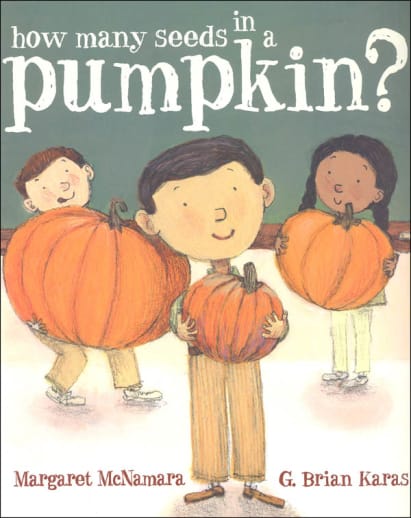This touching storybook covers several lessons that can be leaned through a pumpkin experiment. When Mr. Tiffin brings three pumpkins of different sizes to school, he asks the class to guess which one has the most seeds. To determine the seed count, the class breaks up into groups to extract and count all the seeds. The class is challenged with the task of counting and adding the seeds, working together as a team, learning some facts about pumpkin growth, and being careful not to judge what is on the inside of a thing or person based on the size. Charlie, the smallest boy in the class, leaves feeling uplifted and motivated about the fact that just because his size is small doesn't mean he is a small person on the inside. The back of the book includes seven additional pumpkin facts. 32 pgs, hc.
How Many Seeds in a Pumpkin?
Description
Here is an adorable picture book for curious kids, which explores skip counting and estimation in a fun pumpkin-themed classroom experiment. This book makes a wonderful read-aloud companion to any math or science curriculum, and it's a fun way to reinforce counting skills at home.
"How many seeds are in a pumpkin?" Mr. Tiffin asks his class as they gather around the big, medium, and small pumpkins on his desk. Robert, the biggest kid, guesses that the largest one has a million seeds; Elinor, sounding like she knows what she's talking about, guesses the medium one has 500 seeds; and Anna, who likes even numbers better than odd ones, guesses that the little one has 22. Charlie, the smallest boy in the class, doesn't have a guess.
Counting pumpkin seeds is messy business, but once the slimy job is done, to everyone's surprise, the smallest pumpkin has the most seeds! As Charlie happily exclaims, "Small things have a lot going on inside of them."
| Product Format: | Hardcover |
|---|---|
| Grades: | PK-3 |
| Brand: | Schwartz & Wade Books |
| ISBN: | 9780375840142 |
| Length in Inches: | 10.8125 |
| Width in Inches: | 8.75 |
| Height in Inches: | 0.375 |
| Weight in Pounds: | 0.85 |

